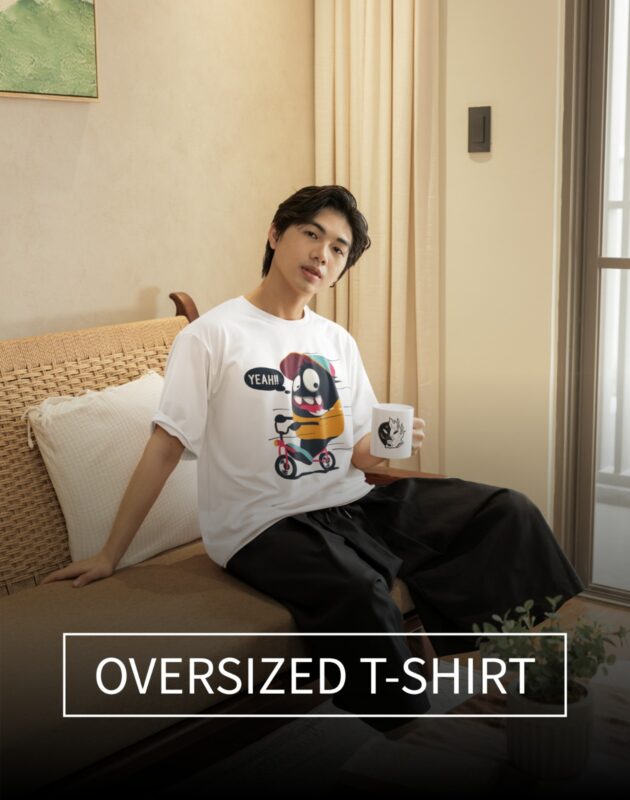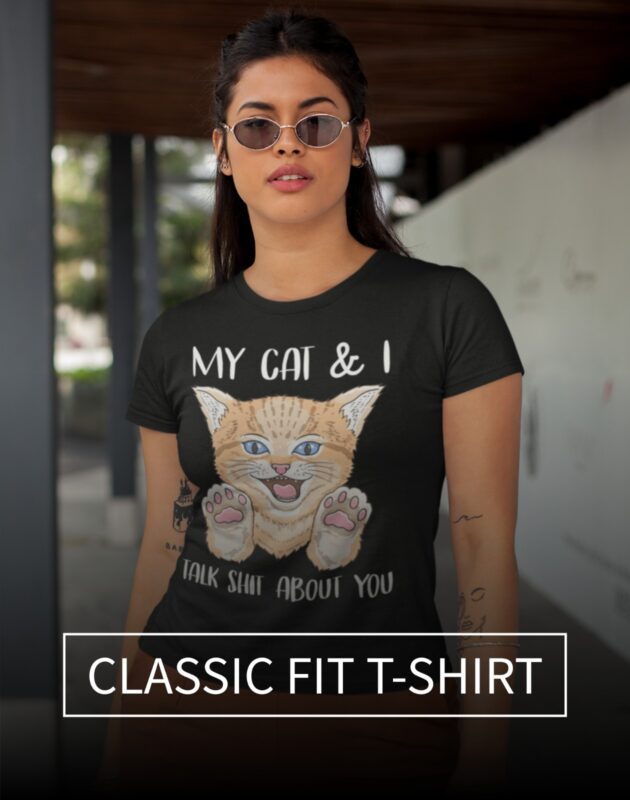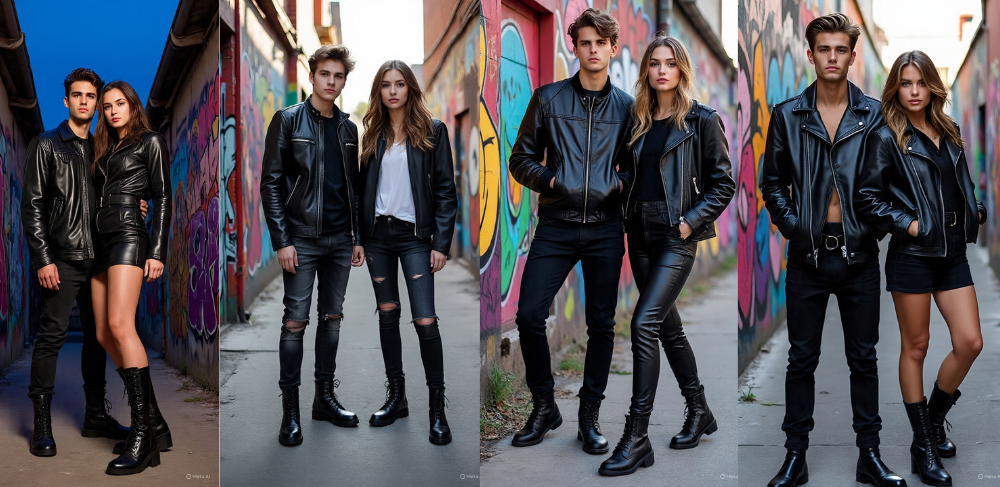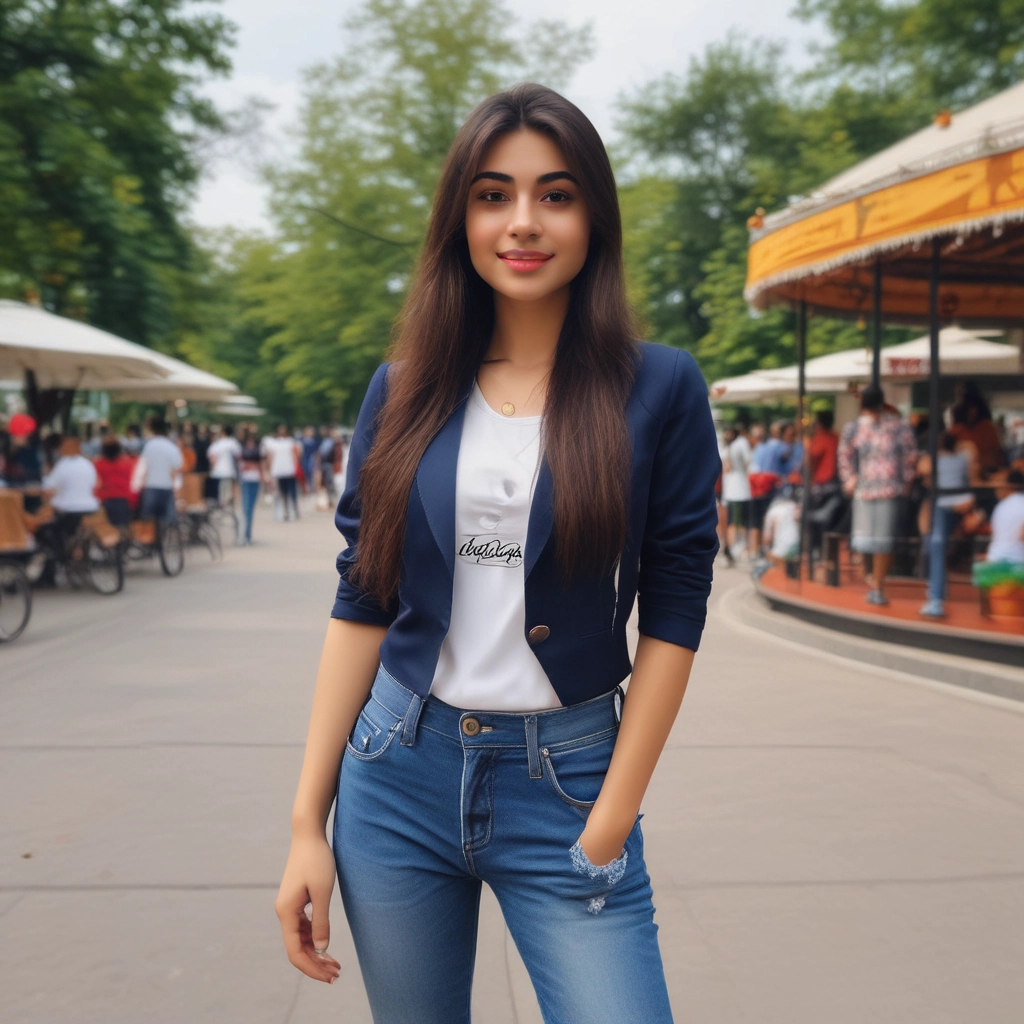India Travel Fashion: Your Ultimate Guide to Looking Effortlessly Stylish in India’s Most Photogenic 7 Cities

India travel fashion isn’t just about what looks good on the ‘gram—it’s about blending comfort, style, and cultural awareness while exploring this vibrant country. India—just the mention of it paints an explosion of colors in the mind’s eye. A country so rich in visual diversity that each turn of the road can offer an entirely new palette, backdrop, and ambiance.
Whether it’s the rose-tinted architecture of Jaipur, the serene ghats of Varanasi, or the Portuguese charm of Goa, India’s top cities are like open-air film sets waiting for you to step in and steal the scene. And of course, what you wear while navigating this photogenic wonderland matters—not just for the gram, but also for your comfort, confidence, and cultural sensitivity.
Welcome to your ultimate travel style guide—crafted with love, aesthetic sensibility, and deep respect for India’s nuanced landscapes and traditions. This isn’t just about looking good; it’s about feeling amazing, being practical, and clicking those Insta-worthy snaps that capture more than just visuals, they capture your spirit.
Why Your Travel Outfit Choices in India Truly Matter
When you travel across India, every city offers its own mood board. Your wardrobe should ideally resonate with the essence of these places. That doesn’t mean carrying half your closet. Instead, it’s about making thoughtful, strategic choices—opting for outfits that flatter you and flow with the scenery while keeping comfort and modesty in check.
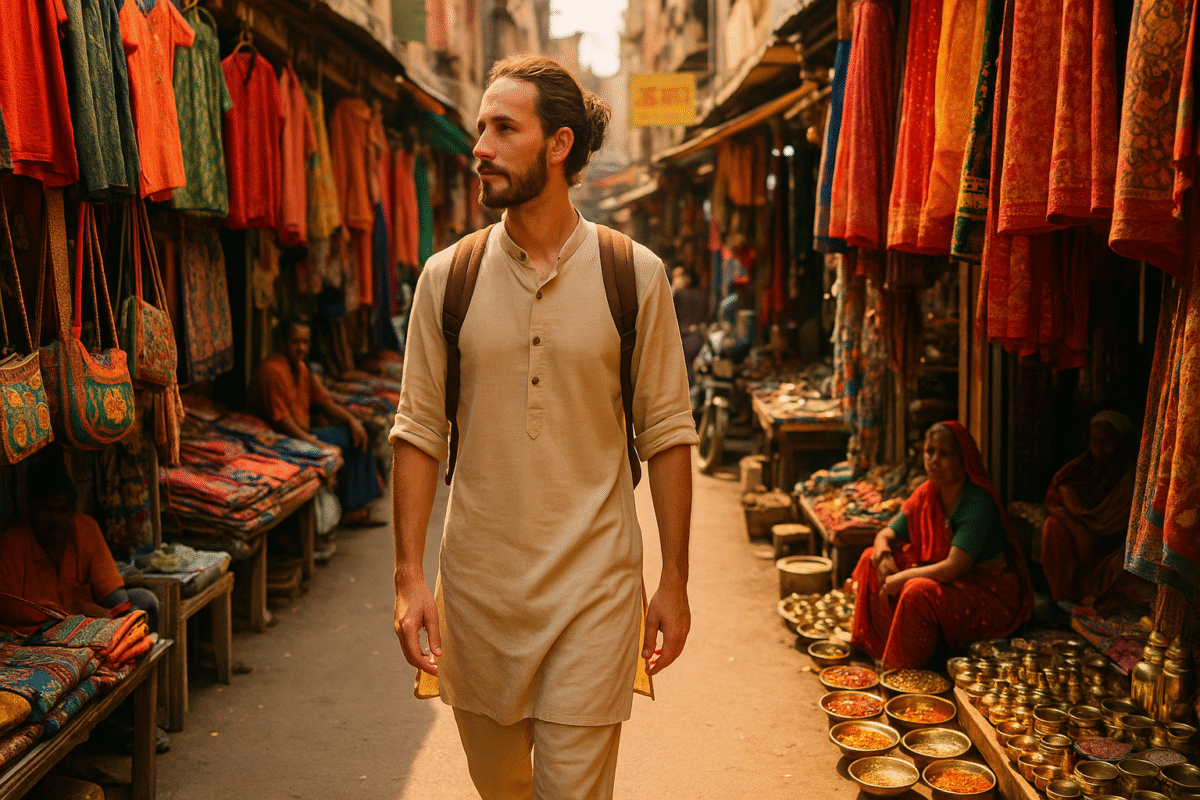
Choosing the right clothes also helps you blend in respectfully, especially in religious or traditional regions. When your outfit syncs with the environment, you don’t just look stylish; you tell a story. A sunset photo at the ghats of Varanasi in a saffron linen kurta is not merely picturesque, it’s poetic. And poetry, as we know, always clicks.
India Travel Fashion Tips: Curating the Perfect Wardrobe
It all starts with the basics—understanding what works universally across Indian cities. From breathable fabrics and color theory to culture-sensitive accessories and reliable footwear, every element plays a role.
Cotton, khadi, linen, and light silk are your best friends. These fabrics aren’t just breathable—they’re practical and versatile. According to the Khadi and Village Industries Commission, khadi is not only eco-friendly but also ideal for India’s tropical climate, making it a smart fashion choice for conscious travelers.
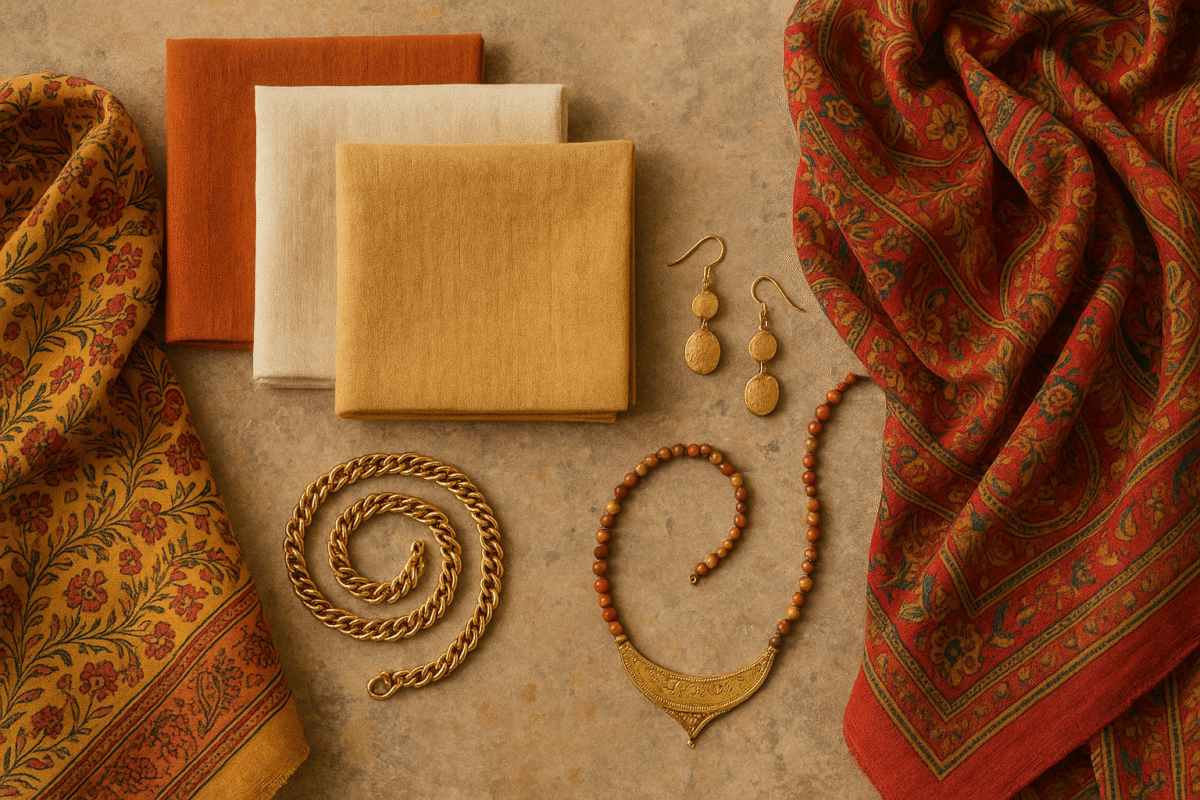
Colors? Think bold jewel tones when posing by heritage walls, and soft pastels for dreamy lakeside shots. Don’t shy away from traditional Indian patterns either. Prints like Bandhani, Ikat, and block motifs can elevate your look instantly while connecting you to the roots of the land you’re exploring.
Cultural Sensitivity is Always in Vogue
Modesty, in many parts of India, is more than just etiquette—it’s a sign of respect. Especially when you step into religious places or rural areas, covering your shoulders and knees isn’t just appreciated, it’s often expected. But worry not; modesty doesn’t equate to frumpy. With flowy maxi skirts, long tunics, scarves, and charming bohemian accessories, modest fashion can be your runway-ready travel aesthetic.
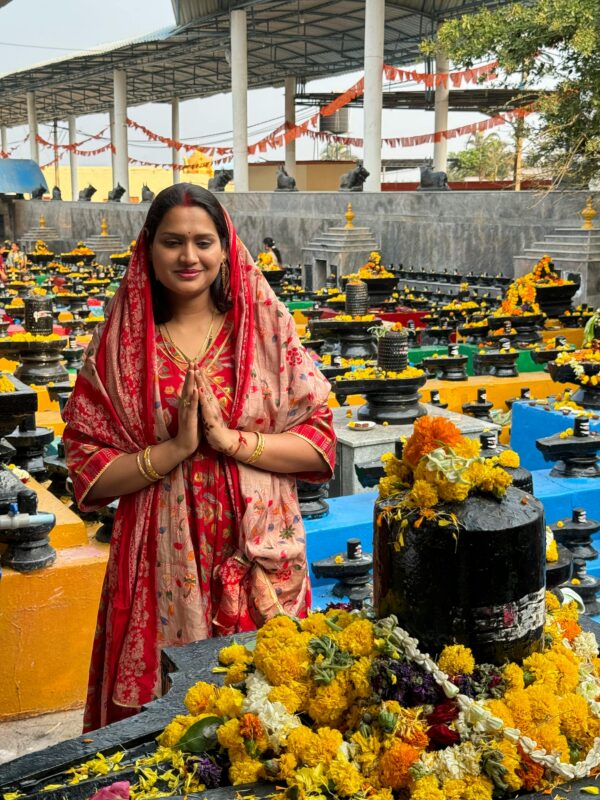
A versatile scarf or dupatta can transform any outfit. Not only does it work as a cover-up, but it also adds color, texture, and an unmistakable Indian flair to your look. Plus, it helps in practical situations—protecting you from sun, dust, or when temple customs ask you to cover your head. Dressing modestly in religious places or small towns isn’t just about blending in—it’s about showing cultural respect. The Incredible India tourism website offers great tips on etiquette and customs that align beautifully with your travel style.
Smart Layering: Be Ready for Climate Mood Swings
India’s climate doesn’t like to play by a single rulebook. Depending on the region and time of day, you might need to swap from sleeveless to woolly in the blink of an eye. Layering is your strategy here. Light jackets, cotton shrugs, denim vests, or chic kimonos are perfect add-ons. They’re not just functional—they’re fashion statements too. When packing for your trip, always check the regional forecast using the India Meteorological Department so you’re prepared for unexpected shifts, especially during monsoon or winter travel across northern cities..
Walking in Style: Footwear that Doesn’t Betray You
High heels? Tempting for the ‘gram, but treacherous for India’s uneven roads. Instead, opt for stylish yet sturdy sandals, espadrilles, sneakers, or juttis. They let you explore freely without worrying about sprained ankles or sore soles.
Whether you’re navigating the cobbled alleys of Old Delhi or dancing at a beach shack in Goa, your shoes should support your journey—both literally and metaphorically.
Indian City Style Guide: Fashion Tips for Every Destination
Each of India’s iconic cities deserves a moment in the spotlight. And what better way to do that than by matching your style to its soul? Here’s a fashion breakdown city-wise, ensuring you never miss a style beat:
Jaipur – What to Wear in the Pink City
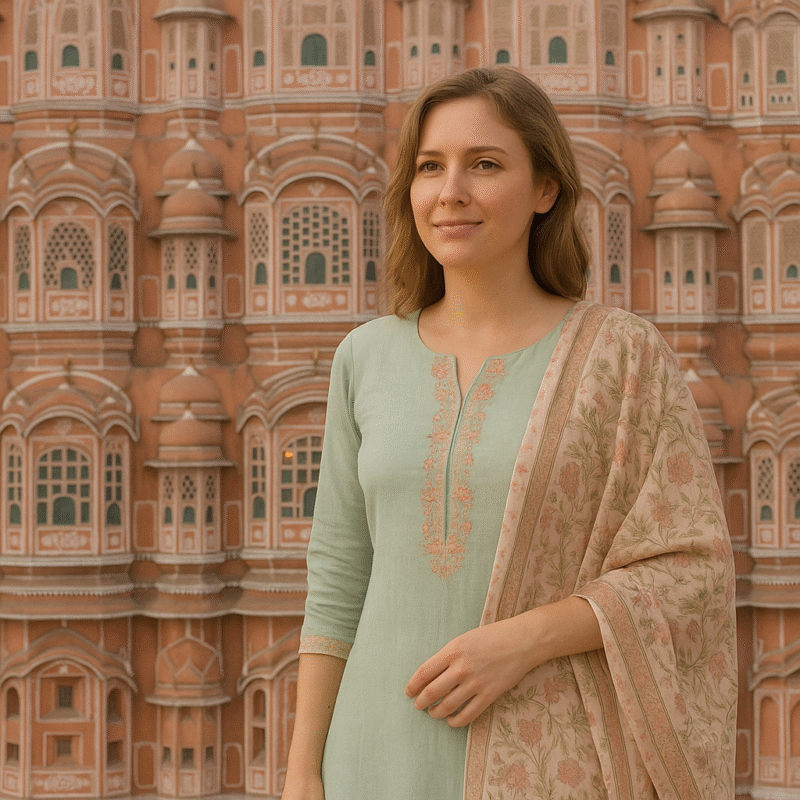
Jaipur is bold, colorful, and full of royal charm. From pastel palaces to busy bazaars, the city is a dream for photos. What you wear here should reflect the city’s vibrant spirit while keeping you cool and comfortable in the dry heat.
For women India travel fashion, flowy Anarkali suits or skirts with crop tops in soft shades like peach, mint, lavender, or rose pink look beautiful against the pink sandstone. If you want a modern twist, a block-printed maxi dress or a boho kurta with wide-leg pants is both stylish and practical. Light fabrics like cotton, georgette, and mulmul work best during the day.
Silver jewelry, colorful bangles, and embroidered dupattas can instantly elevate a simple outfit. You’ll also want a scarf or stole for visiting temples or walking through more traditional neighborhoods.
For men, a crisp cotton kurta in white or beige paired with jeans or churidar pants looks clean and classic. You can also wear a short-sleeve linen shirt with tailored trousers for a modern but comfortable look. Rajasthani-style mojaris or leather sandals add a touch of culture without compromising comfort.Avoid dark heavy clothes or tight fits during the day. Jaipur’s light and color call for softness and flow. You’ll feel more in tune with the city and your photos will reflect it too.
Udaipur – What to Wear in the City of Lakes
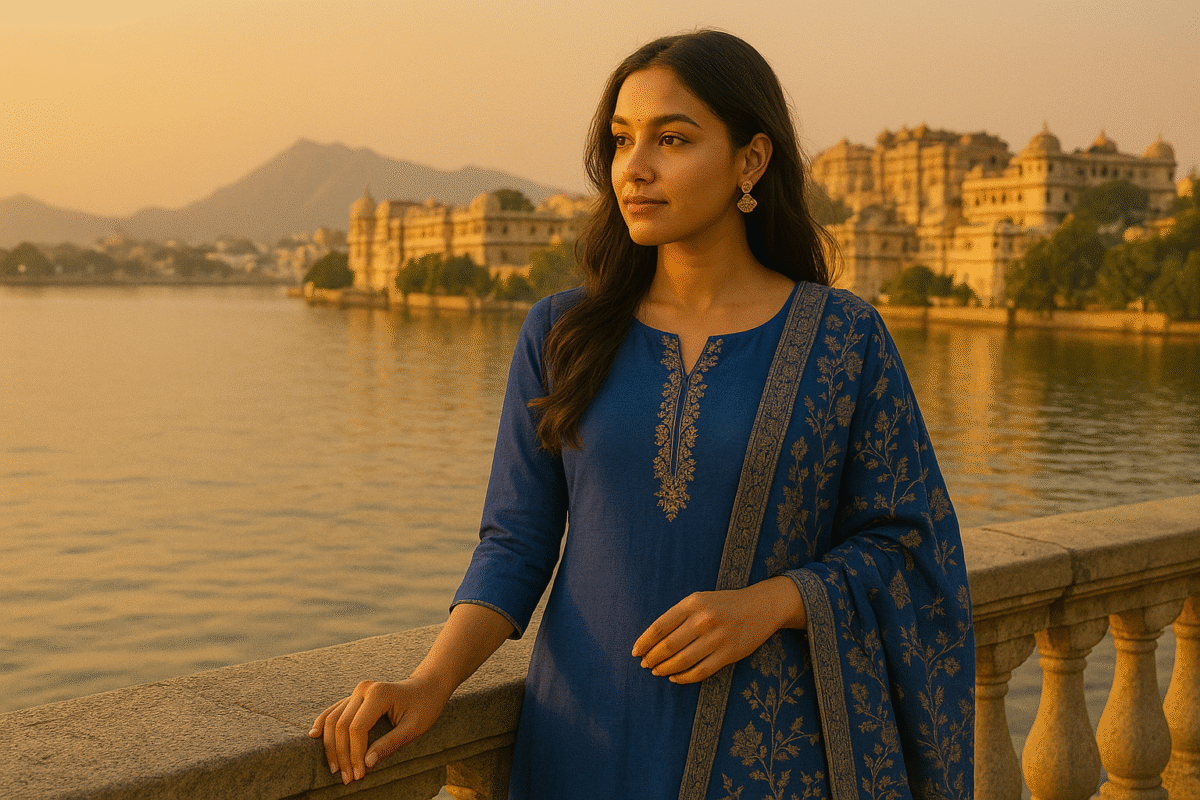
Udaipur is calm, beautiful, and full of quiet grandeur. When you’re planning what to wear here, think of elegance that feels effortless. The city’s lakes and palaces make the perfect backdrop for soft, flowing outfits in rich but soothing colors.
For women India travel fashion, long dresses in jewel tones like royal blue, emerald green, or maroon work well for photos near the water or palace courtyards. If you’re leaning traditional, a light Anarkali or a cotton saree with gold or mirror details looks graceful and blends in naturally with the setting. During daytime walks, a breezy kurta with palazzos will keep you cool and comfortable.
Fabrics like linen, cotton, chiffon, or silk are perfect here. They’re light, breathable, and they move well when there’s a breeze. Accessories like silver earrings or a colorful stole can elevate a simple look without overdoing it.
For men, a soft linen shirt with tailored trousers or a classic cotton kurta feels right for this setting. In the evenings, add a Nehru jacket if you’re going somewhere special. Stick to calm tones like cream, dusty pink, or pale blue. Loafers or clean sandals are both stylish and practical.
Avoid anything too bold or synthetic. Udaipur’s charm is in its softness, so your outfit should feel relaxed and look polished without being flashy.
Goa – What to Wear by the Beach and Beyond
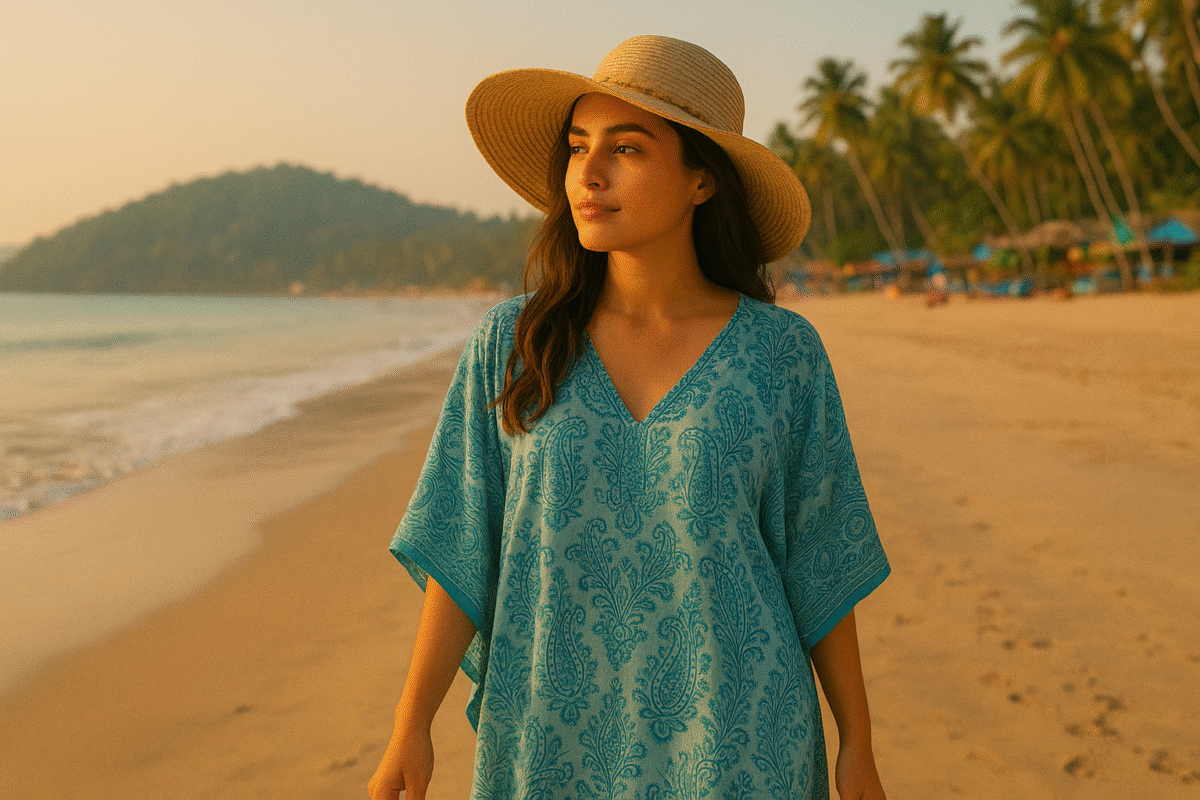
Goa is all about ease. With beaches, old Portuguese lanes, flea markets, and sunset cafés, your outfit should feel as relaxed as the vibe. Comfort, color, and breathable fabrics are key here.
For women India travel fashion, think cotton sundresses, tie-dye skirts, co-ord sets, or kaftans in bright colors like coral, turquoise, yellow, and white. Loose tops with denim shorts or wrap skirts are great for exploring markets or beach-hopping. A bikini top under a cotton cover-up works well for the shore. Lightweight cotton and rayon are ideal in the heat and humidity.
Accessories like beaded necklaces, shell anklets, and straw hats add fun to the look. Flip-flops, waterproof sandals, or espadrilles are best for both sand and street.
For men, airy shirts in floral or tropical prints paired with cotton shorts or drawstring pants work well from beach to bar. Sleeveless tees or open-button shirts are comfortable choices during the day. In the evenings, you can dress it up slightly with a collared linen shirt and neutral shorts or chinos.
Avoid thick jeans or anything heavy. Goa calls for light clothing, open footwear, and relaxed confidence.
Delhi – What to Wear in the Heart of India
Delhi is fast, layered, and full of contrasts. From ancient forts to sleek cafés, your outfit should handle different scenes and changing weather. Prioritize comfort without compromising on polish.
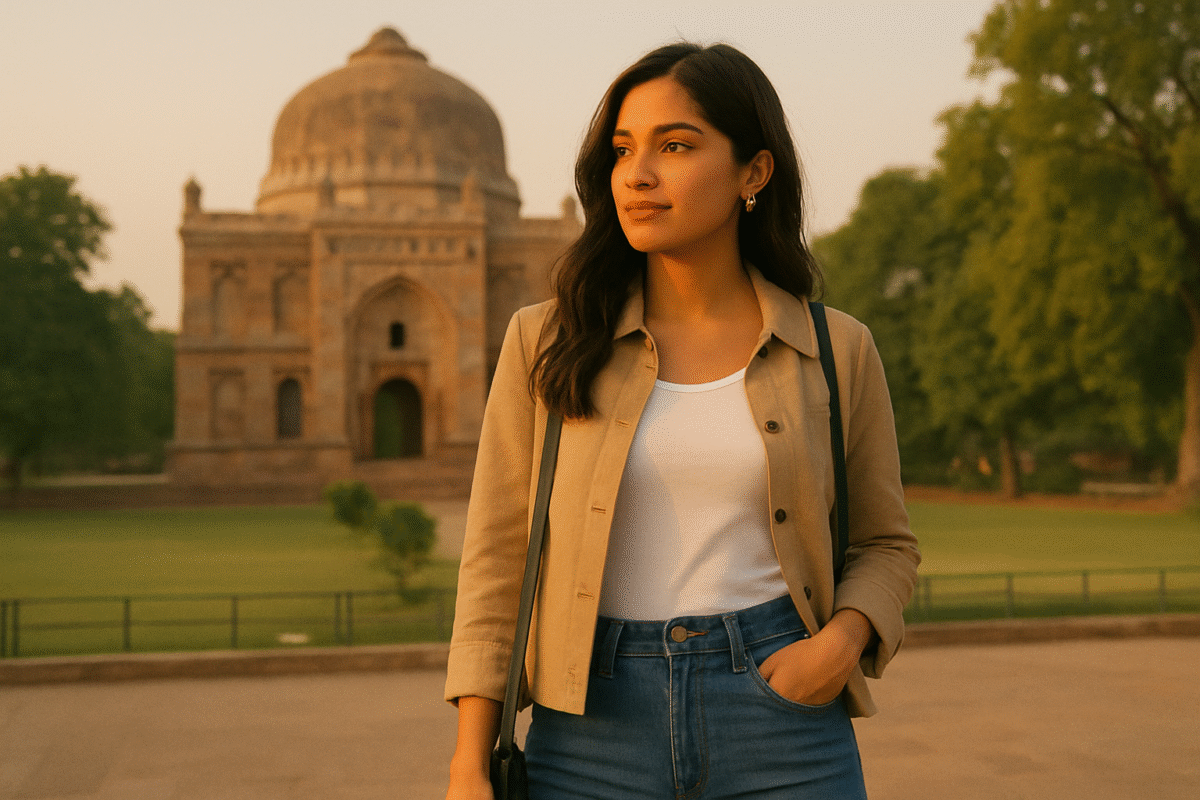
For women India travel fashion, opt for midi dresses, cotton kurtas with straight pants, or linen co-ord sets for daytime visits to historical spots. If you’re out exploring busy markets like Chandni Chowk, loose trousers with a simple blouse or a long kurti offer comfort and modesty. During cooler evenings, add a denim jacket or a lightweight scarf.
Neutral colors like beige, olive, and soft pastels work well for dusty streets and warm light. Comfortable sneakers or closed sandals are a must for long walks.
For men, breathable cotton shirts or casual kurtas in light colors go well with jeans or chinos. In the winter months, layering with a light sweater or a cotton blazer gives structure to the look. A crossbody bag or backpack is helpful for carrying essentials while keeping your hands free.
Avoid tight synthetic clothes in summer or heavy fabrics when moving through busy areas. Delhi rewards those who dress smart, stay light, and keep a bit of edge in their look.
Varanasi – What to Wear in the City of Rituals and River Mornings
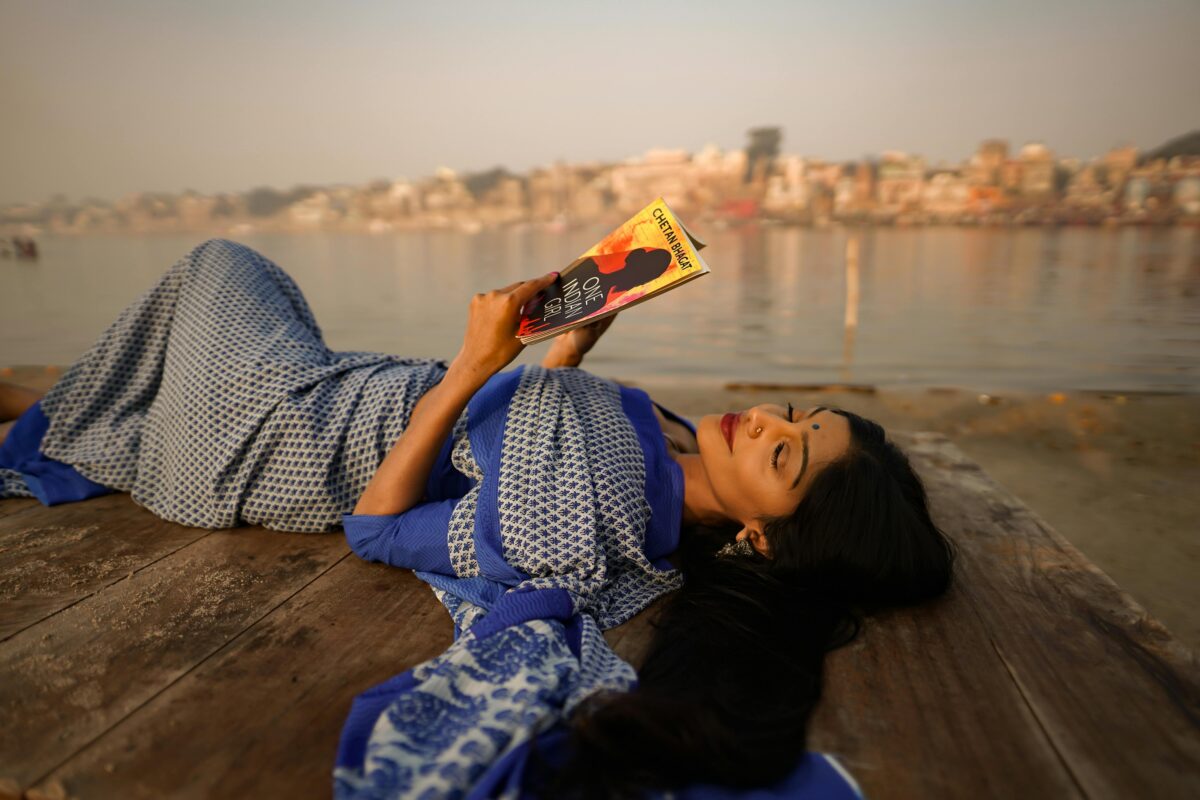
Varanasi has a quiet intensity. Everything here feels older, deeper, more meaningful. As a visitor, your outfit should reflect a sense of respect. Modesty matters, especially around the ghats, temples, and sacred rituals.
For women India travel fashion, lightweight cotton kurtas paired with palazzo pants or long skirts work best. Soft earthy tones like saffron, indigo, ivory, and maroon blend beautifully with the city’s ancient textures. Handloom sarees, especially in muted tones, are also popular among travelers who want to immerse themselves in the local rhythm. Avoid clingy materials or short cuts, especially near temples or aarti ceremonies.
Varanasi’s mornings are cool and peaceful, so it’s helpful to carry a scarf or shawl for warmth and modesty. Comfortable sandals or slip-ons are practical, as you’ll need to remove your shoes frequently when entering religious spaces.Many temples require visitors to remove footwear and cover shoulders and knees. For detailed insights on visiting Indian temples, Cultural India’s temple guide is a great reference.
For men, a simple cotton kurta with loose pajama-style pants or linen trousers keeps the look respectful and relaxed. Neutral shades like off-white, rust, and soft grey work well. Khadi shirts or light button-downs with jeans are another modest, modern option.
Avoid flashy prints, synthetic fabrics, or revealing clothing. In Varanasi, the goal isn’t to stand out — it’s to blend into the calm.
Mumbai – What to Wear in the City That Never Pauses
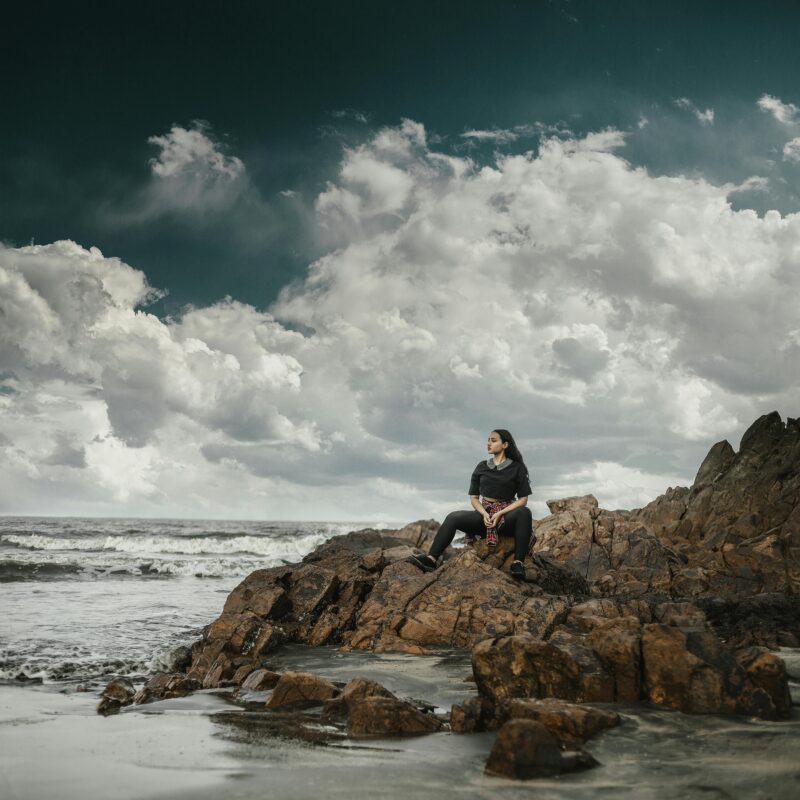
Mumbai moves fast. It’s modern, creative, and always on the go. Your outfit needs to match the pace while keeping you cool in the humid climate and prepared for everything from street food runs to rooftop dinners.
For women India travel fashion, Mumbai offers the chance to play with trends while staying functional. High-waisted trousers with crop tops, cotton jumpsuits, or midi dresses with sneakers are great for city exploring. On cooler days, a linen blazer or denim jacket adds polish without overheating. Lightweight sarees in chiffon or crepe can also be styled for a modern look if you’re attending a cultural event or evening gathering.
Stick to breathable materials like cotton, viscose, or blends that handle heat and moisture. Patterns like stripes, polka dots, or bold florals photograph well against the urban backdrops like Marine Drive or the Bandra-Worli Sea Link.
For men, Mumbai leans towards smart casual. A fitted linen shirt with chinos or dark denim works well from day to night. If you’re heading to a more creative area like Kala Ghoda or Bandra, printed shirts or relaxed t-shirts with overshirts feel right at home. Sneakers are the go-to here, as they suit both walking and social settings.
Avoid heavy layering, uncomfortable shoes, or outfits that wrinkle too easily in humidity. Mumbai’s style is sharp but not stiff. Dress like you’re ready for anything — because here, things change quickly.
Kolkata – What to Wear in the City of Culture and Vintage Charm
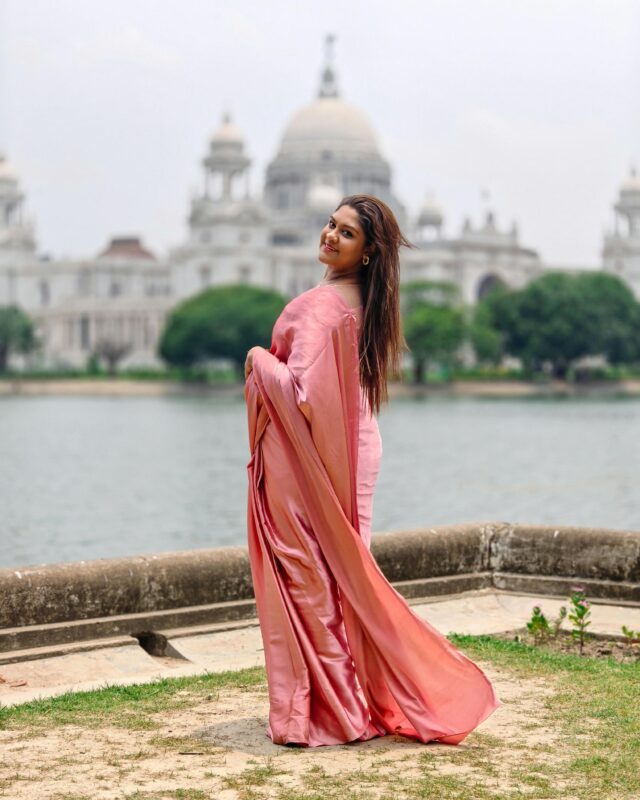
Kolkata feels like a page out of a beautifully written book. From the marble steps of the Victoria Memorial to the narrow lanes filled with yellow taxis and books, the city carries an old-world soul. It’s thoughtful, artistic, and full of quiet elegance. Your clothes here should reflect that kind of character.
For women India travel fashion, cotton sarees are a timeless choice. A handwoven Jamdani or a white saree with red borders captures the city’s essence perfectly, especially during festival time or a heritage walk. If sarees aren’t your thing, you can go with a kurta made from mul cotton or linen paired with cigarette pants or a long skirt. Soft earthy colors work well here. Shades like ochre, rust, soft grey, and off-white blend naturally with the colonial buildings and gentle light.
A leather satchel or a cloth tote works well for carrying your essentials. When it comes to shoes, flats or Kolhapuris are comfortable and still look stylish. Oxidized jewelry or a cotton scarf adds just the right amount of detail without doing too much.
Men have the chance to try something traditional in Kolkata. A classic white Panjabi kurta with pyjama trousers feels right at home, especially for temple visits or evening outings in cultural areas. If you prefer something more modern, a light cotton shirt with chinos or dark jeans is a safe and sharp choice. Stick to breathable fabrics because even in winter, Kolkata can be warm during the day.
Avoid synthetic clothing or anything too loud. In Kolkata, beauty lies in comfort, detail, and thoughtful choices. You don’t need to overdo it. A well-made kurta or a beautifully draped saree can say more than any trend.
Dressing for the Season: A Smart Packing Guide
India’s seasons can be intense and unpredictable. Here’s how to dress for each:
- Summer: Light, breezy clothes, sunhats, and SPF are your survival kit. Stick to whites, pastels, and flowy silhouettes.
- Monsoon: Waterproof everything! Quick-dry fabrics and rubber footwear will keep you happy even in sudden downpours.
- Winter: Layers are key, especially in the North. Shawls, boots, and thermals are a must, while the South remains mild and perfect for cotton blends.
Accessories: Your Outfit’s Best Friend
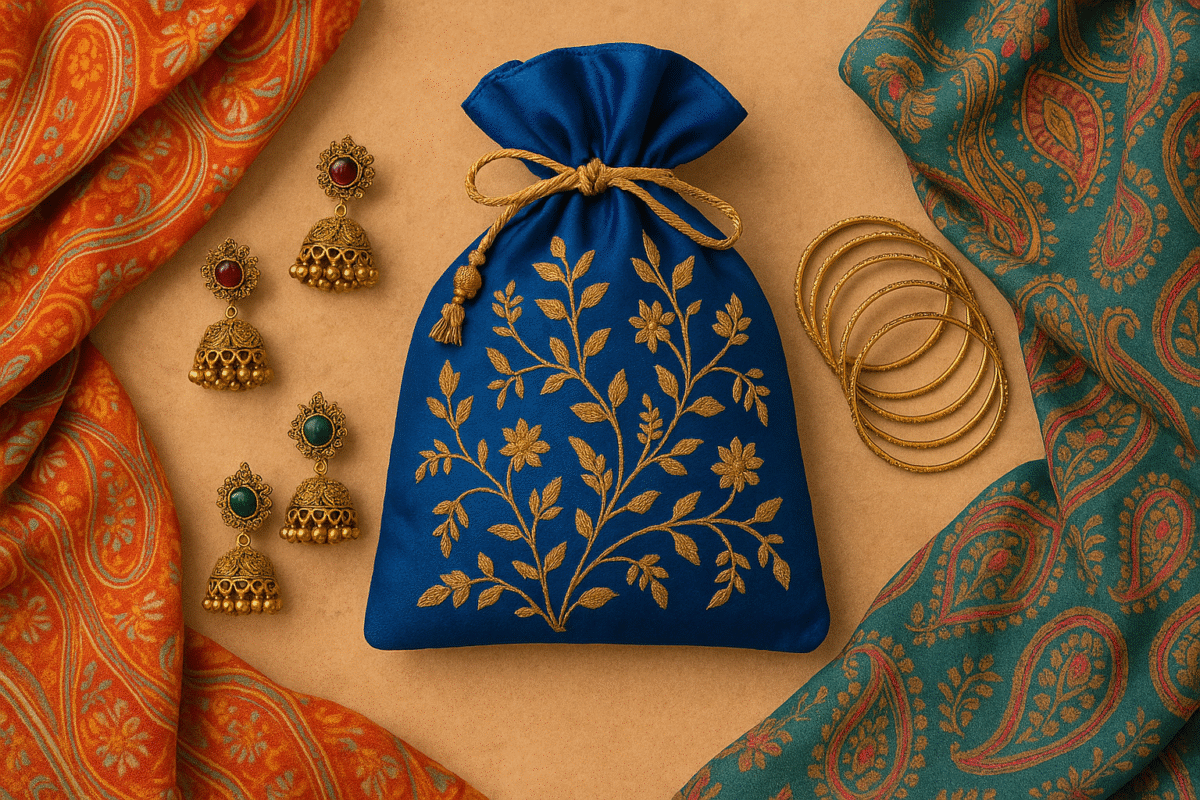
Sometimes it’s not the outfit but the little extras that really pull everything together. In India, accessories are everywhere — and they’re full of personality. A pair of silver jhumkas can take a plain kurta and make it look festive. Beaded anklets, colorful bangles, or even just a bold ring add something fun and personal to your look. A scarf or dupatta is not just for style, either. You can throw it over your shoulders, use it to cover your head at a temple, or just wear it to add color when your clothes feel a bit too plain.
Bags and props matter too, especially if you’re thinking about photos. An embroidered sling bag or a tiny potli can be super useful while still looking good in pictures. And if you like that vintage feel, carrying a film camera or an old-school notebook gives your travel photos a nice touch. Sunglasses, a straw hat, maybe even a bright umbrella in the monsoon — these things aren’t just practical, they make your photos pop. Honestly, it’s the small touches that make an outfit feel like yours.
What Not to Wear in India
To avoid any cultural faux pas:
- Skip ultra-revealing outfits in traditional or rural regions.
- Avoid heavy synthetic fabrics in summer or monsoon.
- Ditch heels unless it’s a formal indoor event.
- Never wear shoes inside homes or temples.
- Avoid offensive graphics or slogans on clothing.
Conclusion: Style Isn’t Just About Fashion—It’s About Feeling Fabulous While Being Respectful
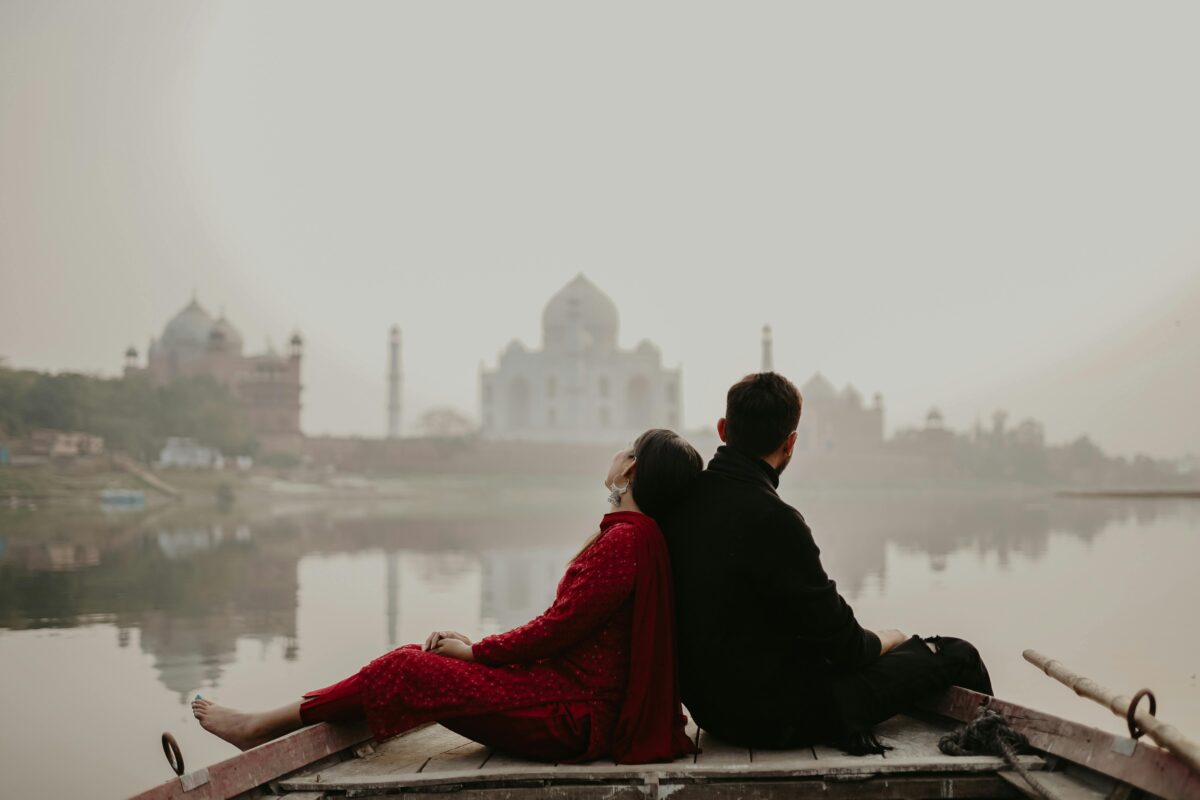
India is more than a destination. It’s a visual, cultural, and emotional journey. Your travel outfits should be an extension of your story, helping you engage more deeply with each place. So, whether you’re catching the first light at the Varanasi ghats or twirling in front of Jaipur’s pink palaces, dress for the moment and make it unforgettable.
Because at the end of the day, it’s not just about the picture—it’s about the feeling it captures.
FAQs
What fabrics are best for traveling in India?
Lightweight, breathable fabrics like cotton, linen, rayon, and khadi are ideal for most parts of India. These keep you cool in hot weather and are easy to move in, especially when exploring markets, monuments, or walking longer distances.
Is it okay to wear western clothes while traveling in India?
Yes, western clothes are totally fine in big cities like Mumbai, Delhi, and Bangalore. However, in smaller towns or religious places, it’s best to dress modestly. Think longer skirts, loose pants, or tops with sleeves. You can always layer with a scarf to feel more comfortable and respectful.
What should women avoid wearing in Indian temples or rural areas?
It’s a good idea to avoid outfits that show too much skin like short skirts, crop tops, or strapless tops. Many temples require you to cover your shoulders and knees. Carrying a scarf or shawl makes it easy to adjust your outfit on the go.
Do I need special clothes for visiting holy cities like Varanasi?
Holy cities are more conservative, so modesty is important. For women, long cotton kurtas, loose pants, or sarees are a great fit. For men, cotton shirts or kurtas with full-length pants are both respectful and comfortable.
Can I wear shorts and sleeveless tops in Goa or the beach areas?
Yes, Goa and other coastal regions are very relaxed when it comes to clothing. Shorts, tank tops, sundresses, and swimsuits are all perfectly fine, especially near the beach or at resorts. Just remember to carry a cover-up when leaving the beach.
What kind of shoes are best for sightseeing in Indian cities?
Comfort should come first. Closed-toe sneakers, walking sandals, or traditional juttis are perfect for exploring. High heels are not practical for uneven paths or historical sites. Slip-on shoes are also useful since many places ask you to remove footwear.

